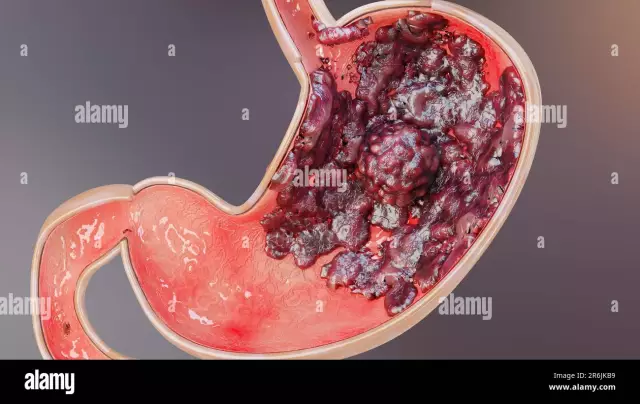- Author Curtis Blomfield [email protected].
- Public 2023-12-16 20:44.
- Last modified 2025-01-23 17:01.
Every day the human body is forced to fight with the penetration of various foreign agents into the body. Pathogenic microorganisms, viruses, fungi and parasites enter us through damaged skin, digestive system, nasal and pharyngeal mucosa and cause various diseases. And only thanks to immunity (the word is derived from the Latin immunitas and literally means "to free from something") we are protected from such a large-scale invasion. Of great importance is the lymphoid tissue, which is distributed throughout the body and in total makes up 1% of the total body weight. So what is it?

Definition
One of the types of connective tissue in which the system of macrophages and lymphocytes is located is called lymphoid. It can be presented as separate organs, or it can simply be a functioning part of the body. There is lymphoid tissue in organs such as bone marrow and spleen, lymph nodes andthymus. In them, it is a functioning parenchyma.
In the mucous membrane of some organs there are also accumulations of lymphoid tissue - bronchi, urinary tract, kidneys, intestines and others.

Functions
In all defense reactions, without exception, lymphoid tissue takes the main part. It contains lymphocytes, macrophages and blasts, plasma cells, mast cells and leukocytes protect the body from invading foreign cells and remove damaged cells of the body itself. The lymph nodes, thymus gland and intestinal (lymphoid) tissue are responsible for the formation of cells of the immune system.
If a bacterium or virus enters through the damaged skin, a defense reaction is activated in the lymph node closest to the site of penetration, lymphoid cells and macrophages are released, which move along with the lymph and blood to the place where the “alien” is found. In the event of a mass attack, when the forces of one lymph node fail to cope, the entire immune system turns on.
Building
Lymphoid tissue is most often free cells supported in a network of reticular fibers. The network can be denser in composition (forms a dense tissue) or loose (with spaces where free cells can move freely). The fibers themselves are formed from type III collagen.

Clusters
In places of the greatest probability of entering alien organisms, largeaccumulations of lymphoid tissue. Familiar to everyone, the tonsils are the lymphoid tissue of the pharynx, located on the border with the oral cavity. They are pharyngeal, palatine, tubal and laryngeal. The totality of all the tonsils and areas is the lymphoid tissue of the nasopharynx.
Its function is very important for our he alth, because it neutralizes microbes that enter through the mouth and nose. And together with organs containing lymphoid tissue, it ensures the formation of the required number of lymphocytes for the whole organism.
Among other things, the lymphoid tissue in the throat interacts with the endocrine glands (adrenals, thyroid, thymus, pancreas), forming a close connection "pituitary gland - adrenal cortex - lymphatic tissue" before the child's puberty.
What is hypertrophy
A child from three to ten years old may develop hypertrophy of the lymphoid tissue of the tonsils, while its functioning is not disturbed. Only with the onset of puberty does hypertrophied tissue begin to decrease.
It is not known exactly what this process is connected with, but the alleged causes are inflammation of the pharynx or infection, various endocrine disorders. Hypertrophy can lead to frequent inflammation or pathological changes in the ears, nose, and larynx.

If nasal breathing is disturbed, ventilation of the lungs is weakened. Later, this leads to a change in the composition of the blood - hemoglobin and the number of erythrocytes decreases, and leukocytes increase in number. Further, the functions of the gastrointestinal tract, thyroid gland, and adrenal glands begin to be disturbed. Violation of all processes leads to a delay in the growth and sexual development of the child.
What is hyperplasia
The term "hyperplasia" came to us from the Greek language and means supereducation. At its core, this is a pathology in which cells begin to multiply rapidly, increasing the volume of tissue.
But hyperplasia of lymphoid tissue is not a disease, but a symptom. The response of the body to the appearance of an infection or inflammatory process in the body. Outwardly, this is especially noticeable in the lymph nodes. There are three types of lymph node hyperplasia:
- Infectious. The immune response to any infection leads to the production of lymphocytes and macrophages in a fast mode, this causes the growth of lymphoid tissue.
- Reactive. Bacteria and microbes enter the lymph node, where their metabolic products accumulate, the toxins they release, causing, in turn, the active release of macrophage cells.
- Malignant. Any cells of the lymph node can be involved in this pathological process, which leads to a change in its size, shape and structure.
Lymphoid tissue is one of the most important components of the immune system of our body. It helps to prevent many diseases even before the infection gets inside along with food and air. It also performs other functions, the mechanism of which has not been fully studied.

Sometimes the lymphoid tissue becomes inflamed, and diseases such as appendicitis, tonsillitis, and many others appear (depending on the locationlocalization of lymphoid tissue). Very often in such cases, doctors resort to surgical methods of treatment, in other words, they remove the affected area or organ. Since all the functions of lymphoid formations have not been fully studied, it cannot be 100% certain that such removal does not harm the human body.






